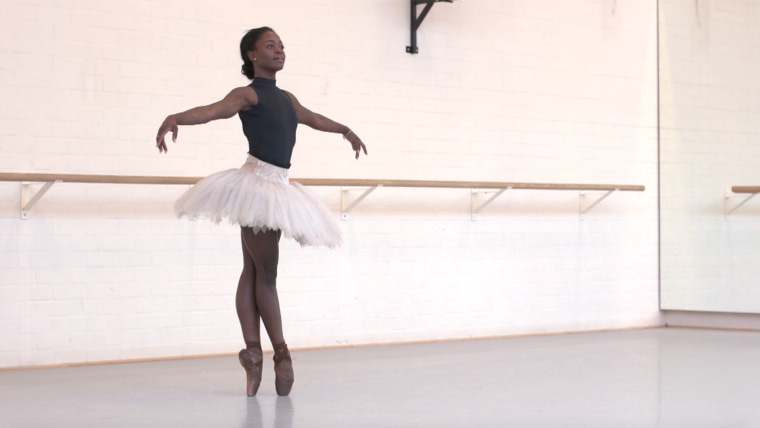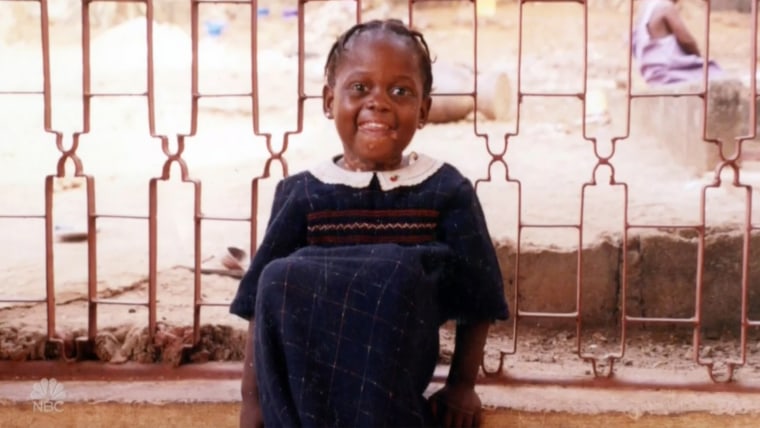
Michaela DePrince is the embodiment of what it means to fight for your dream. The 2017 TODAY Style Hero wouldn't let anything stop her from becoming a professional ballerina: not her childhood, race or vitiligo.
Without knowing her violent past, it might be hard for anyone to imagine that ballet dancer Michaela DePrince was once a hopeless orphan, nicknamed "the Devil's Child" because of the white dots that freckled her dark skin.
After all, the grace with which she pliés and pirouettes across world-class stages is a sharp contrast to a childhood marked by murder and fear.
"The only way I could survive was ... to prove everybody wrong," Michaela, today a dancer for the Dutch National Ballet, told NBC News.
She was born in the African nation of Sierra Leone in the midst of a brutal civil war. Her parents died when she was a toddler, and Michaela, then named Mabinty Bangura, was sent to an orphanage. There, she was an outcast because of her vitiligo, a skin condition characterized by loss of pigmentation in certain places, what Michaela calls her "spots."
The women at the orphanage ranked the children according to their favorites — Michaela was last, no. 27, she remembers, meaning she got last dibs for food and clothes, and she was less likely to be adopted.
"They kept saying, 'Why would somebody want to adopt the devil's child?'" she said.

She found solace in two places: One was her closest friend, also named Mabinty, who was no. 26 at the orphanage. They would sing and play pretend and tell stories about what their lives would be like if they were adopted. The other was a magazine she'd found after a gust of wind blew it against a fence. On its cover was a photograph of a ballerina.
"I showed this to my teacher," Michaela, 22, said. "And she explained to me she was a ballerina dancing ballet. And that's what I wanted to be.”
"It was not just the fact that she's a ballerina," she added. "It's that she looks happy. And I wanted to be happy and ... if what she was doing made her happy, that's what I wanted to do."
She clung to that idea. It offered her hope when she was surrounded by violence. Once, when she was only 3 years old, Michaela was even slashed in the stomach herself, after watching rebels murder her pregnant teacher.

"When I got stabbed, I was really hoping ... I felt very much alone," she said. "I really wanted to die."
Meanwhile, in New Jersey, a woman named Elaine DePrince had made plans to adopt a child from Africa — specifically, Michaela’s friend, Mabinty. But ahead of her trip, there was some confusion.
“I got a call from the adoption agency,” Elaine told NBC News. They said, “Which Mabinty are you adopting? We have two of them.”
When Elaine learned that the other Mabinty had been turned down by 12 families because of her vitiligo, she said she would adopt both of the girls. But even when she arrived to pick them up, Michaela was skeptical.
“She was standing there with her arms folded really angry,” Elaine said. “I think … she just thought there was going to be more rejection ahead of her.”
“I see her walking towards us, and then she takes our hands and she says, ‘I’m your new mama,’” Michaela said.
Elaine renamed the girls Michaela and Mia, in honor of her late adopted son Michael, who had died from AIDS. He had urged her to adopt from Africa.
One of the first things Michaela did was show her new mother the image of the ballerina.
“I couldn’t believe that I had adopted an orphan from Africa who wanted pointe shoes!” Elaine said. “I had to promise her … she would dance.”
It took a while for Michaela’s new reality to sink in.
“I remember the first two, three years in the U.S., I kept thinking, ‘I’m going to wake up. I’m going to be back in Sierra Leone,’” she said. “That’s what really scared me.”
“I used to have to sleep with the light on,” she continued. “Like, I was just terrified that if I turned it off, when I would wake up, I would be in the orphanage again.”
Never miss a moment! Sign up for our weekly Style newsletter.
Eventually, she settled into her new life. Michaela excelled at dance lessons and set her sights on becoming a professional ballerina. She knew there would be hurdles to face: Specifically, she worried about her vitiligo. Before her first show, she asked her mother to tell her if she could see the spots from where she sat in the audience.
“I said, ‘No, not really. They looked like pixie dust,’” Elaine said. “And she says, ‘Oh good. Now I can be a professional ballerina.'”
Later Michaela realized being black would be an issue, too. She tells a story about a teacher who once told her she didn’t put much effort into working with black ballerinas because “they all end up getting fat and having big boobs.”
But at that point, Michaela was plenty used to overcoming struggle. At age 17, she became the youngest ballerina with the Dance Theatre of Harlem in New York City. The next year, she was hired by the Dutch National Ballet, and she now calls Amsterdam home. For Michaela, it’s a dream come true — but one she earned.
“It’s not a fairy tale, you know,” she said. “You have to work hard. There is a lot of loss, a lot of pain. But you know, performing? I love it.”